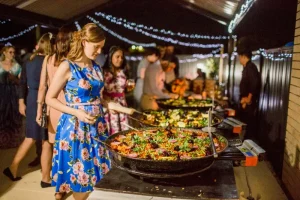Paella isn’t just a blend of rice, saffron, and more. It’s a tradition, a performance, and a celebration of flavour; all cooked in one pan. But to truly do it justice, you need more than the key ingredients. The right accessories can enhance your paella from good to palatable. Believe it or not, the gas burner in your background, your kitchen stove, and other essential accessories can make a difference. Want to know how? Scroll and read further.
The Paella Pan (La Paellera)
Everything begins with the pan. Wide, shallow, and carbon steel pans are the best choice here. Due to their shape, the rice cooks evenly and forms that crunchy, coveted socarrat; the crispy golden crust at the bottom that people love to relish. That’s the same kind of pan experts use in paella catering, where consistency and flavour are paramount.
When choosing a pan:
- Go for a carbon steel version if you’re after authenticity.
- Choose one based on the number of servings, not the size of your burner.
- Avoid nonstick pans. They prevent the socarrat from forming.
Prefer easier maintenance? Then go for stainless steel or enamel-coated pans. But with these, you may not get the same depth of flavour.
Heat Source
Even heat distribution is key. That’s why your standard kitchen burner might not cut it for larger pans. You have a few options:
- Paella Gas Burners: These are ringed burners designed to match the size of your pan.
- Open Fire: If you have outdoor space, this is the traditional method.
- Grill or BBQ: A solid compromise that gives you control and smokiness.
- Stovetop (for small batches): Works if your pan fits over the burner evenly.
Pro tip: Avoid cooking on induction unless the pan is induction-friendly; even then, it’s not ideal.
Tripod or Burner Stand
If you’re cooking outdoors, a sturdy tripod stand or burner support is essential. It keeps the burner level and your paella pan stable. No wobbles, no spills.
Choose one that matches your burner size. Some stands even come with adjustable legs to level the surface on uneven ground.
Lid or Foil (Optional but Helpful)
Traditionally, paella is not covered while cooking. But there are exceptions. A large lid or some aluminium foil can be a lifesaver if you’re dealing with wind, inconsistent heat, or simply trying to keep the rice moist after cooking.
Just don’t use it while the socarrat is forming. That needs dry heat and time.
Long-Handled Utensils
You’ll be working over the heat for a while. A long-handled slotted spoon or wooden spatula helps stir and distribute ingredients evenly without risking burns.
Avoid using metal spatulas that scrape the bottom unless you’re trying to test for socarrat doneness.
Ingredients Prepping Tools
While not exclusive to paella, having the right prep tools makes your life easier:
- Sharp chef’s knife
- Cutting board
- Small bowls for mise en place (pre-measured ingredients)
- Citrus squeezer (if you’re finishing with a touch of lemon)
Good prep is half the battle in paella-making. Once the heat is on, you won’t have time to chop.
Oil Dispenser
A small glass or metal oil dispenser gives you precision. Too much oil can drown your rice; too little and your pan dries out too fast. With a dispenser, you stay in control. Look for one with a spout that gives a slow, steady stream.
Blow Torch or Heat Gun (For the Brave)
This is a bit unconventional, but if your heat source struggles to deliver the perfect socarrat, a blow torch can help finish it. Just a few controlled passes across the bottom of the pan can do the trick.
It’s a modern cheat, sure, but an effective one when used carefully.
Final Thoughts
Like every other dish, paella is as much about the process as it is about the result. And like any other craft, with the right tools, it’s much easier and more enjoyable.
But you don’t need to break the bank at once to buy everything. Start with the basics. A reliable pan, consistent heat, and a trusty spoon. As your paella game levels up, so can your gear.
The soul of paella is in the details. How the rice cooks, the ingredients blend, and how you respect the crust.







